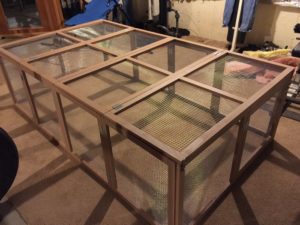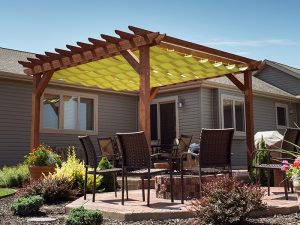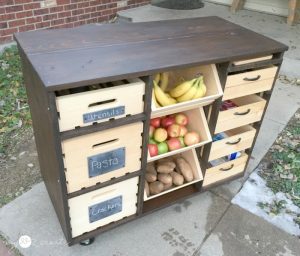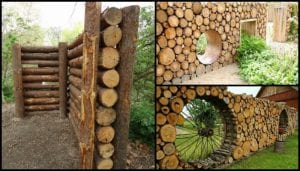Last Updated on February 20, 2024 by teamobn
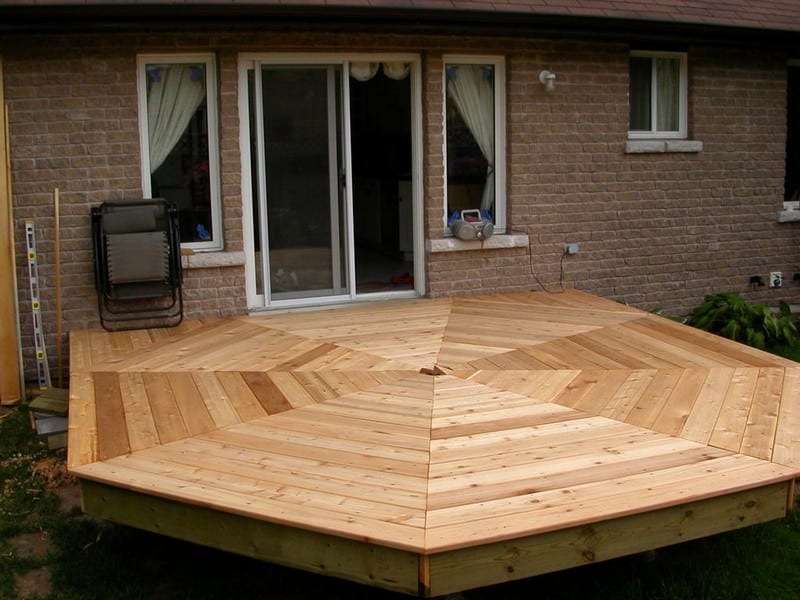
Investing in an outdoor deck allows you countless benefits. The fresh air and sunshine boost levels of Vitamin D, a vital hormone that protects you against a range of diseases. The outdoors also improves your mood by decreasing anxiety and increasing happiness.

A deck is your oasis. It’s a perfect place for relaxation and a space that allows you to escape from your worldly troubles. It can be the best place to host parties, entertain guests, or simply enjoy some sun or cool breezes.
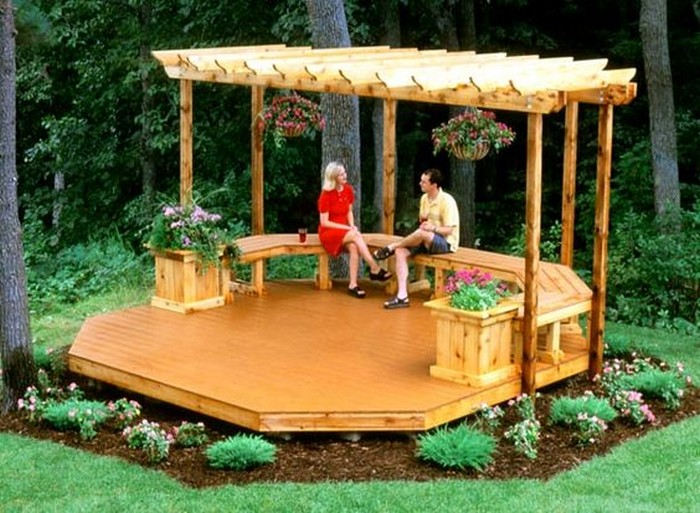
This 12-foot deck is a perfect example. The unique octagonal deck shape sets it apart from conventional decks. It’s owner-built and costs about $1500 Canadian, excluding tax and maintenance.
Could you use one of these octagonal decks in your backyard?
Click on any image to start the lightbox display. Use your Esc key to close the lightbox.

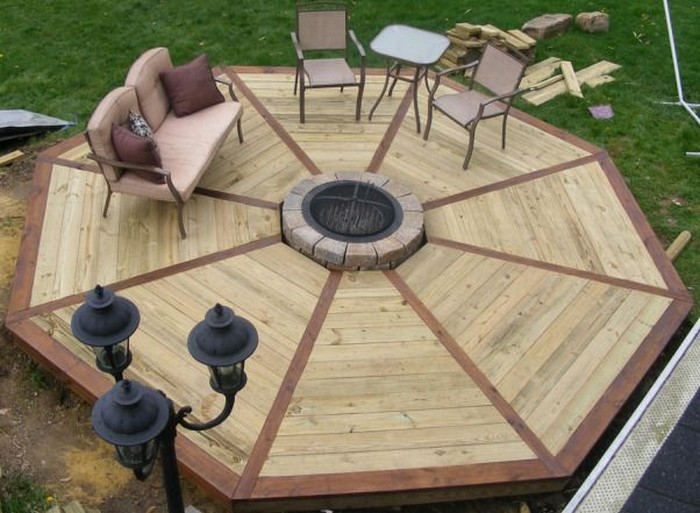
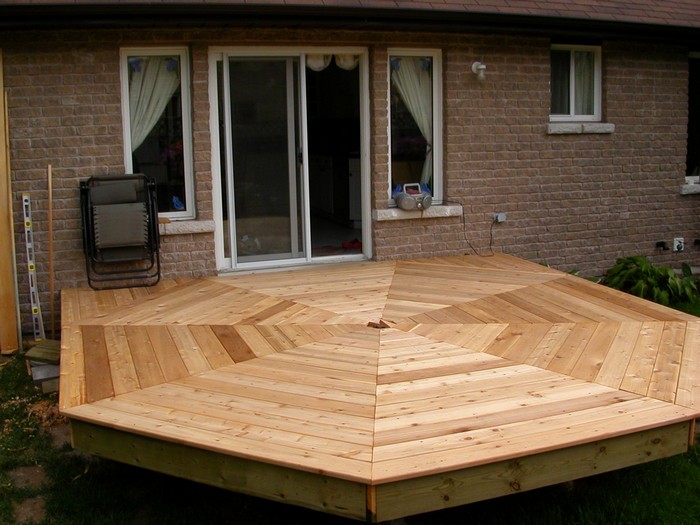
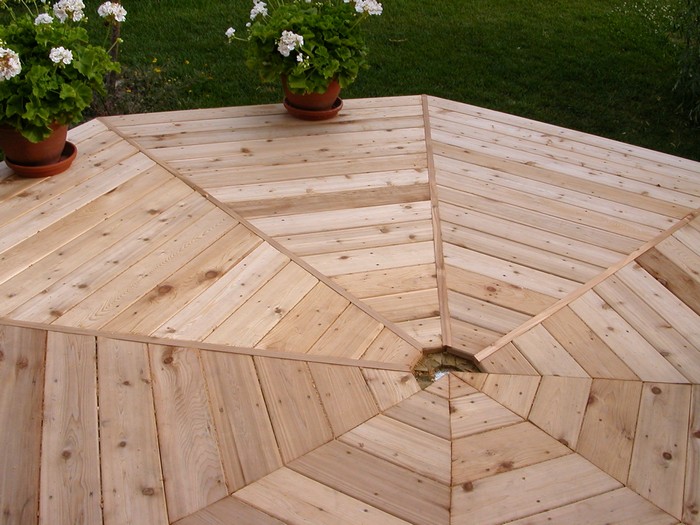
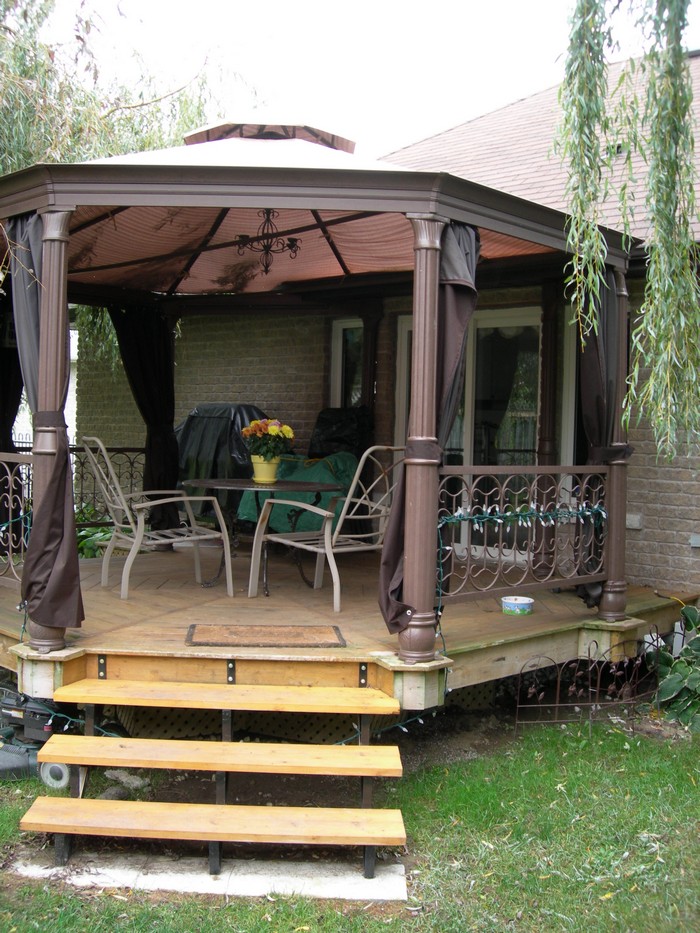
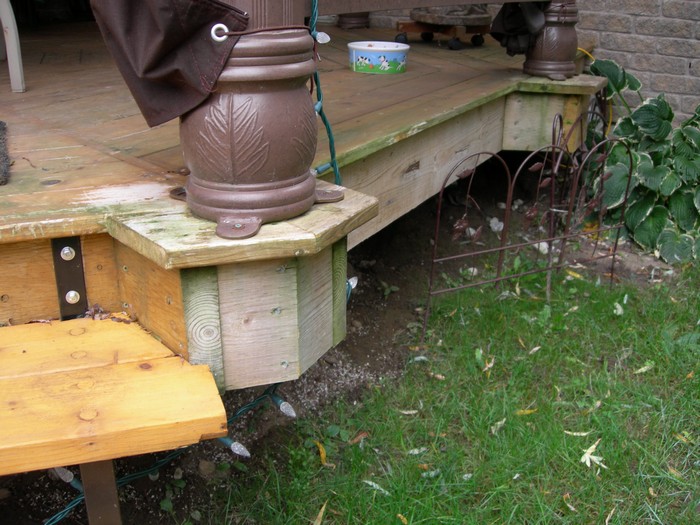
Building an Octagonal Deck
Materials:
- 2x8x14’ Pressure Treated Lumber
- 2x8x8’ Pressure Treated Lumber
- 4x4x8 Pressure Treated Lumber
- 1-1/4x6x8 Cedar Decking
- Cement Mix
- 10” x 8’ Sona Tube
- 6” x 4’ Sona Tube
- Sona Tube Saddles
- 4” Bolts, Nuts, Washers
- Screws
- Joist Hangers
- Wall Anchors
- Cabot Deck Coating
- Wood Glue
Tools:
- Hammer
- Clam Shell Shovel or Post Hole Auger
- Cordless Drill
- Hand Circular Saw
- Shovel
- Wheelbarrow
- Stringline
- Chalk
Steps:
This is a 12 ft diameter cantilevered octagonal deck, with poured concrete piers. what follows assumes you will want to attach the octagonal deck to the house. Find a spot 6 feet from the edge of your house (plus an allowance for a ledger board) more or less centred on the house entrance.
Mark this spot as the central support column of the octagonal deck. Drive a peg. Attach your string to this peg and, draw a chalk circle of radius 6 feet and a second circle of 4 feet. Start marking the position of each of the 8 support posts. String a line to the right edge of your door and drive a peg at the intersection of this line and the 4-foot circle.
Carefully counterclockwise rotate the string 45 degrees. Strike this second chalk line and hope the subtended angle covers the door entrance. If it does, drive a peg at the 4-foot intersect. If it doesn’t, fiddle with these two lines so that the45 degree arc is centred on the door frame. After these first 2 pegs are in, progress around the circle until all post holes are pegged.
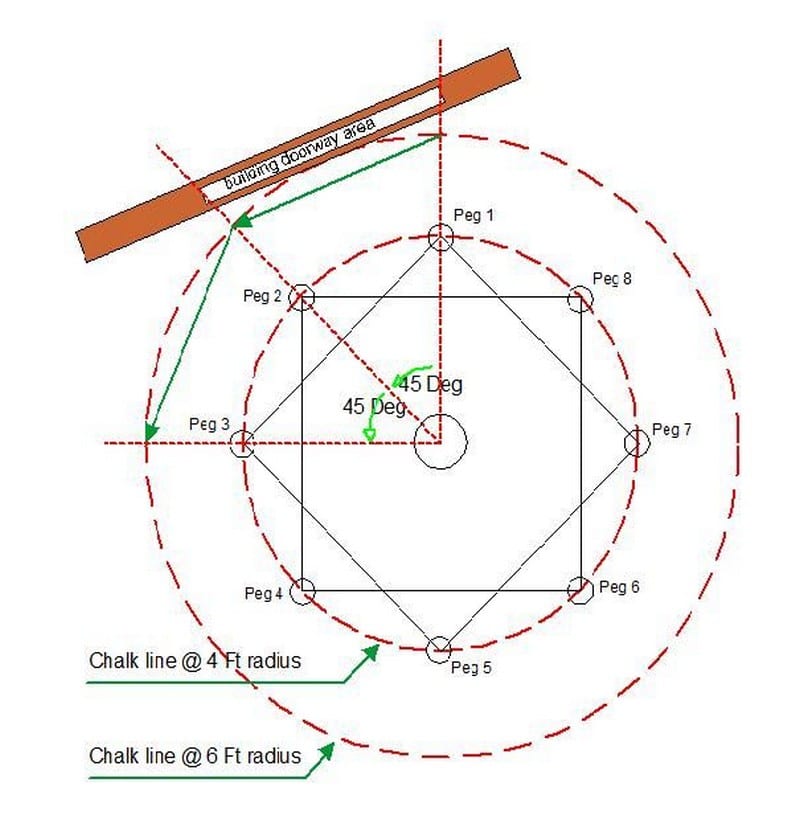
At the centre post peg, dig a hole below frost level. In my county, that means a minimum of 42 inches. Use a length of 10-inch Sona tube in this hole. Before pouring the concrete, mark the height of the pour by marking the periphery of the Sona tube at a point a joist width and a deck plank thickness, below the level of your house doorway.
Cut the Sona tube at this height, mix the concrete, and pour it into the top. Embed a 4-inch carriage bolt in the centre. I used a 3/4-inch bolt. I didn’t use rebar for my octagonal deck, you may wish to.
Now dig a hole for each of the 8 outer posts of the octagonal deck using a 6-inch Sona tube, below frost level, and about 3 inches above the ground. Now don’t pour until you review the next step when you will embed saddles in the 8 posts.
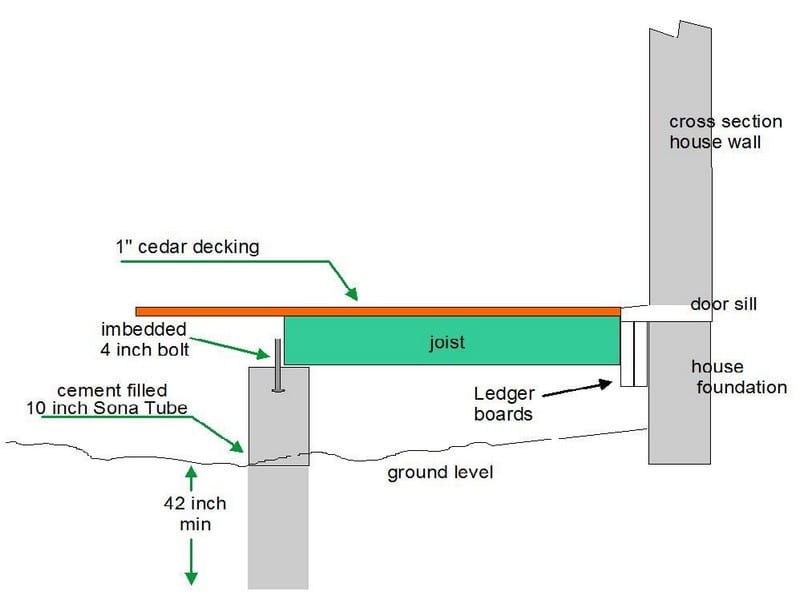
Refer to the first diagram. When embedding the saddles in the outer 8 post pours, embed the saddles in post 1 and post 3 to align with the rectangle shown in the first diagram. Continue next with posts 5 and 7 following the same rectangle.
I call these the ODD-numbered posts. The EVEN numbered posts of the octagonal deck are poured and the saddles are aligned again using the second diagram as a guide. Align post 2 and post 8 saddles, followed by post 4 and post 6. Why becomes clear in the next two steps.

With the concrete firm, use the 3-inch deck or brass screws to fasten a pressure treated 4″x4″ upright in each of the 8 saddles of the octagonal deck. These uprights are marked and cut so that the top of each is level with the centre post of the octagonal deck. Screw pressure-treated planks to the uprights to form a rectangle flush with the top of each upright.
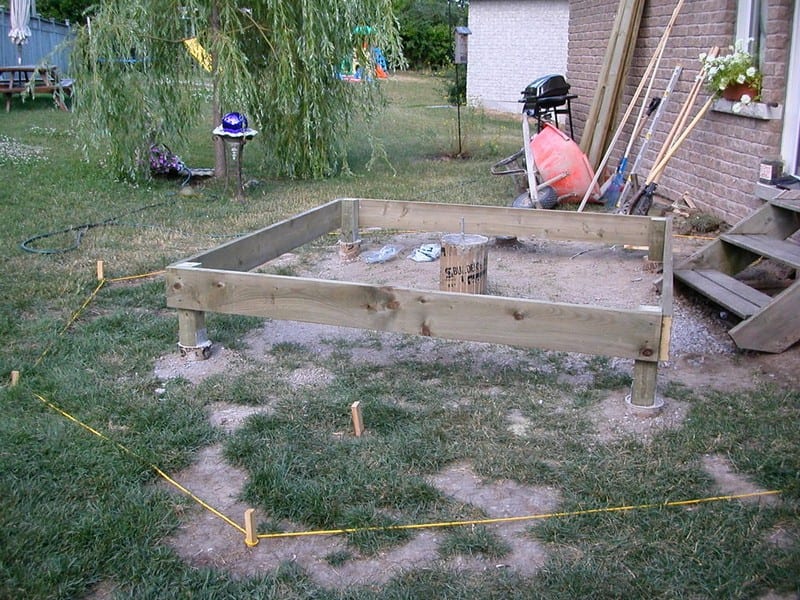
As in the previous step, the ODD numbered posts are framed to create a rectangle that intersects the rectangle of the EVEN posts. Follow the image, screw the pressure-treated lumber in place and then double up the rectangles.
What we have now is an 8-pointed polygon which is the deck foundation. Each Point or Vertex of the polygon will support a deck joist. (If you start the rectangle with the ODD numbered posts, it doesn’t matter, as long as you end up with the 8-pointed polygons.)
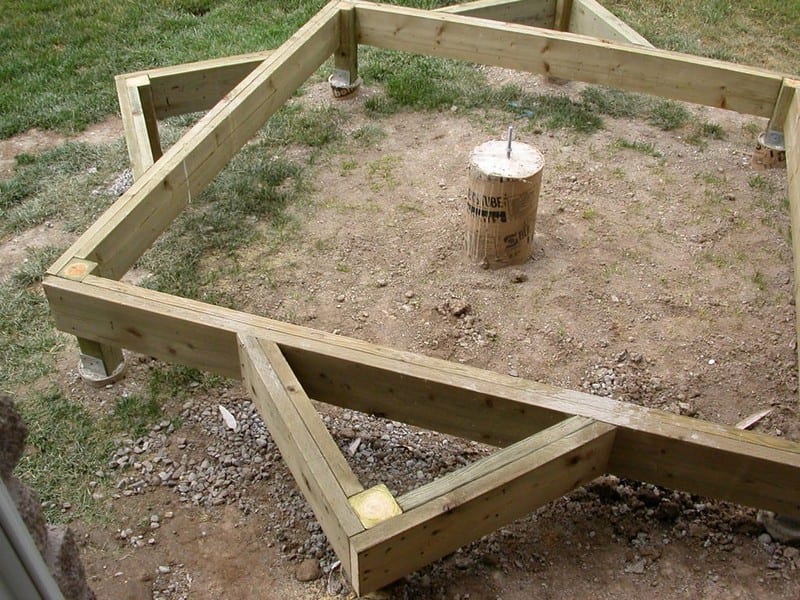
There are 8 main deck joists, each crossing vertices and resting on the centre post, giving us a 2-foot cantilever to the deck. Each joist is 6 feet long and sits at an angle of 45 degrees from adjacent vertices.
Note that the joists are pushed together at the centre post and as shown in the next step, four of the joists have been cut at a 45-degree angle to assure a tight fit. The joists will eventually be held down with the bolt in the centre post.
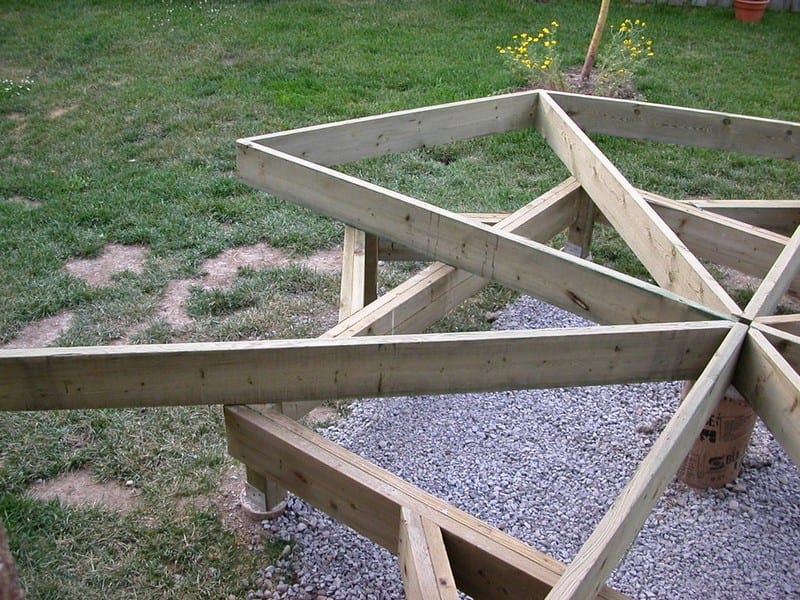
This is a detail to show the joists of the octagonal deck mounted on the centre post. They should be pushed together, as we proceed.

The circumference of the octagonal deck is formed by the end joists. This picture gives some detail about the calculation of the length of each end joist. Frankly, my advice is to cut one end of the end joist at 22.5 degrees; measure twice, then cut the second end at 22.5 degrees!
The real secret here is to keep the subtended angle at 45 degrees. This calculation is based on a zero-width line; at the very least the results are out by the joist thickness. How many planks have you ever seen that have the same thickness? Take the calculation as an approximation only.
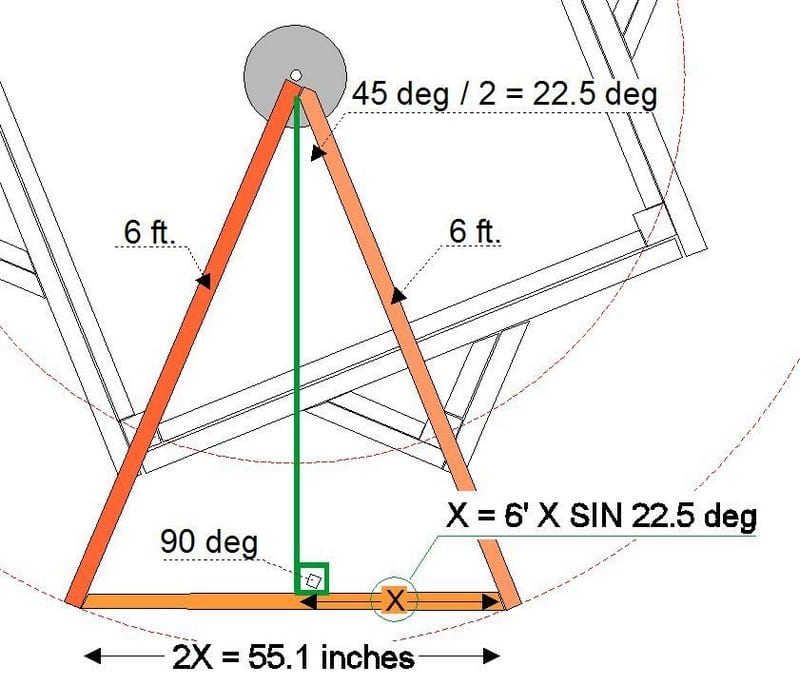
This is a picture from the kitchen door after all the end joists have been installed. Look carefully and you see the joist ends on the centre post of the octagonal deck are still floating free. At this point, you can rotate the deck joisting to adjust the deck orientation to the house entrance.
When you are satisfied that the orientation is O.K. screw each main joist to the corresponding vertice. At this point, I sloped the ground under the deck and covered it with several inches of gravel.
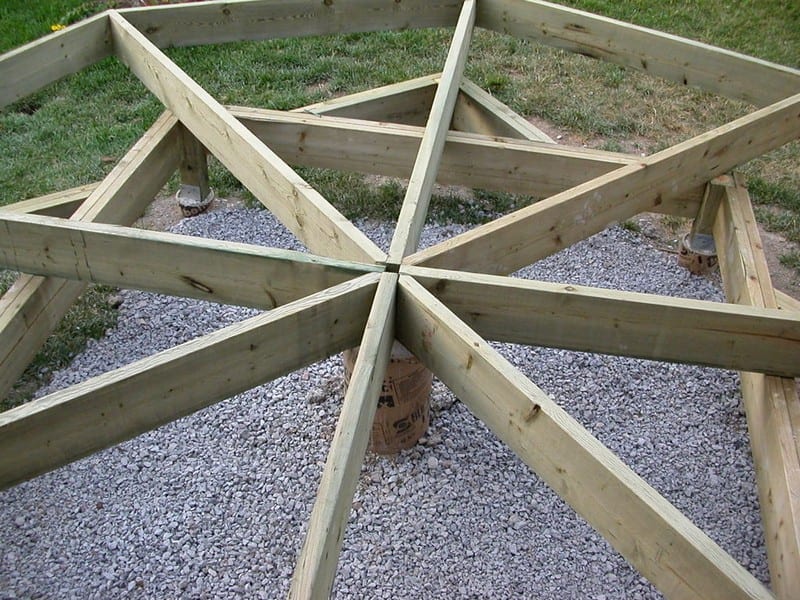
I used 2 ledger boards here to accommodate two vent pipes and to assure that I had an attachment surface beyond the entrance lintel. Notice I have installed the first couple of CROSS joisting. There is a lot to come. Last, this is a good time to bolt down the centre post end of the joists.
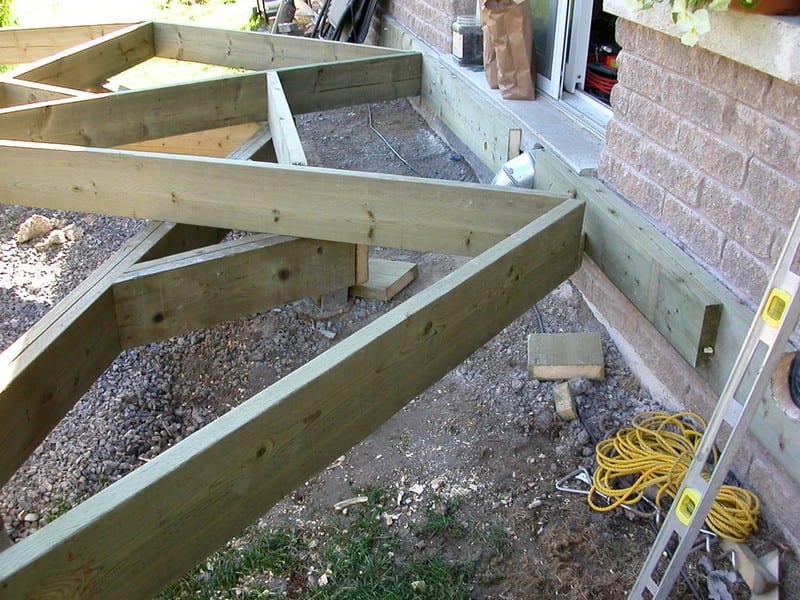
The 4-inch Carriage bolt embedded in the centre post is too short to extend to the top of the joists, so I up-ended a second bolt and connected both bolts, giving me a way to clamp the joists down.
Of course, I started by screwing a second nut and a large-diameter washer to that second bolt, beforehand. This is a temporary solution, which we will alter when finishing the decking.
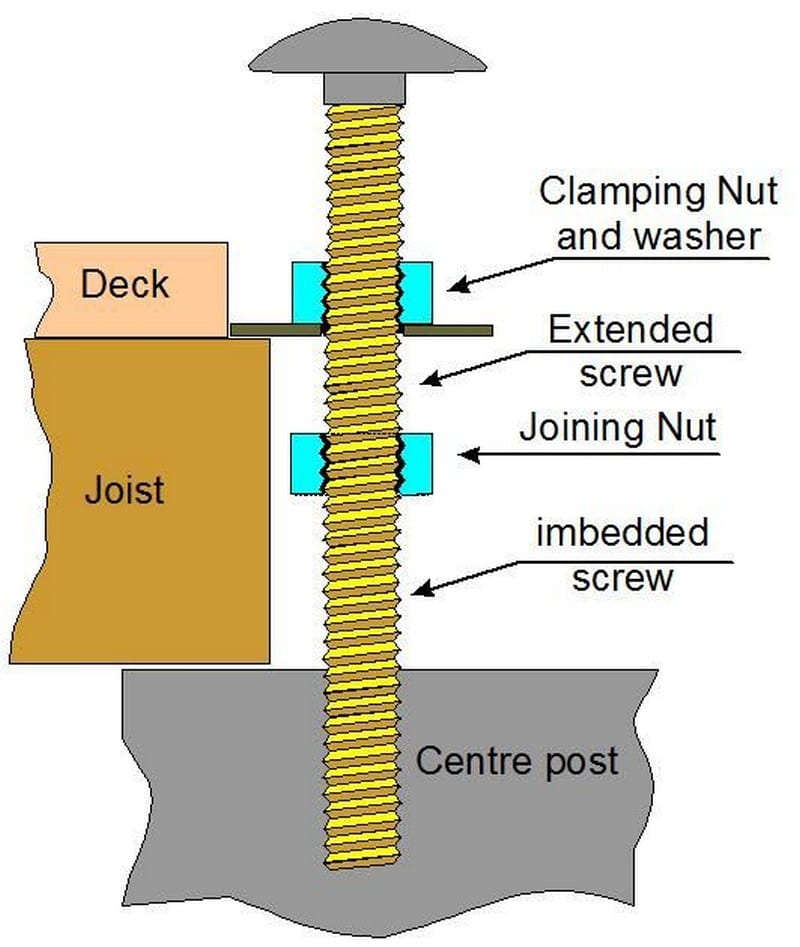
The Cross joists are perpendicular to the end joists set at 16-inch centres. Notice that the joists are clamped at the centre. This matrix of Joists, End Joists, and Cross joints of the octagonal deck is extremely strong.
Can you see the last one I was about to install, which ends the task of installing the joists for the octagonal deck? All joists are secured with deck screws.
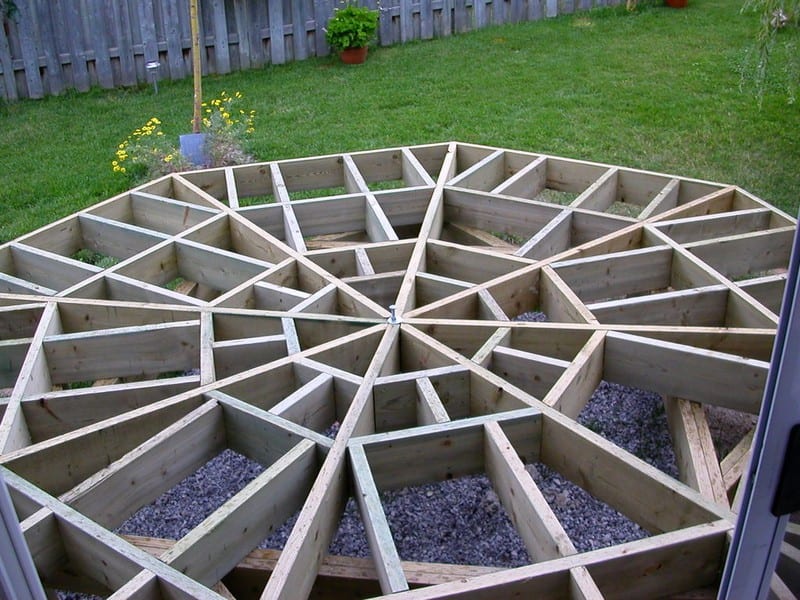
Start at the outer edge of the deck and work inwardly to the centre of the octagonal deck. The first row of decking overhangs the end joists by 1-1/2 inches.
Each piece of of the octagonal deck planking is fastened between adjacent main joists. Use deck screws, alternately driving the screws either to the front edge or bottom edge of the plank in a zig-zag pattern.
DO NOT screw down the ends of the planking at this time, keep the joints tight. Proceed around the periphery, with no spacing between planks. From time to time, you will have to rip a board to keep the progression even. Keep the scrap, it will fit an inner circle. (Note the upper left of the picture!)
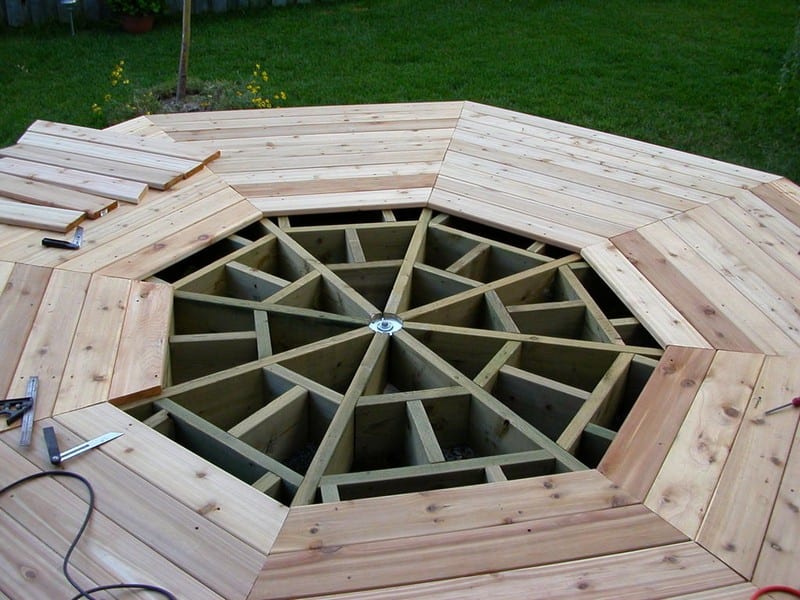
As you get closer to the centre of the octagonal deck, you will need to insert some scrap joisting to provide a surface to mount the decking.
Additionally, since the deck planking is firmly holding the joisting together, we have the opportunity to modify the centre post clamping screw to assure that the final pieces of decking can be fastened in the centre, without interference.
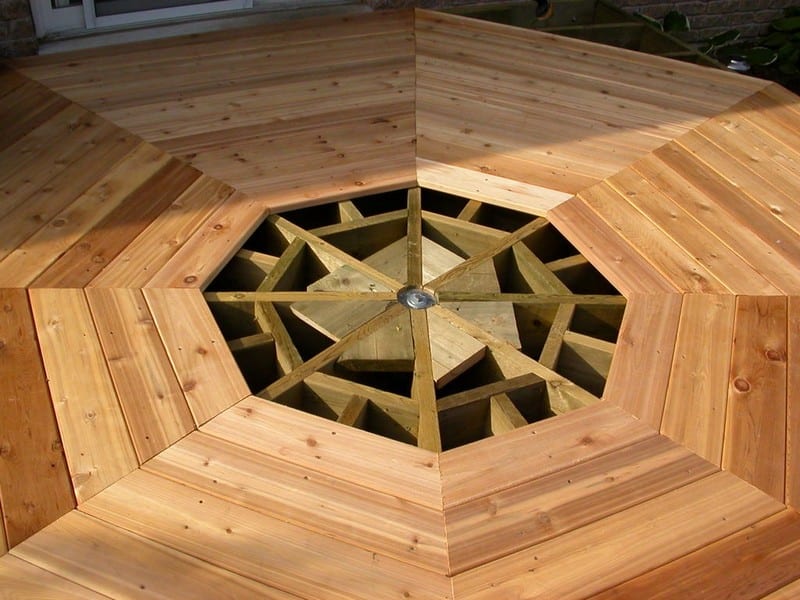
To get the clamping screw and nut below the bottom of the octagonal deck surface, we need to chisel out the edges of the main joists around the clamping screw and nut to accommodate the big washer.
In Fact, at this point, I installed a second smaller washer between the clamping nut and the original large washer to reinforce the larger washer. Follow the image here and cut the deep enough to accommodate the screw and washer(s) and wide enough to JUST accept the largest washer.
Mark the excess bolt length above the clamping nut, disassemble the nut and washer structure, and then hacksaw the bolt to length. You will probably have to try this a couple of times to get it right.
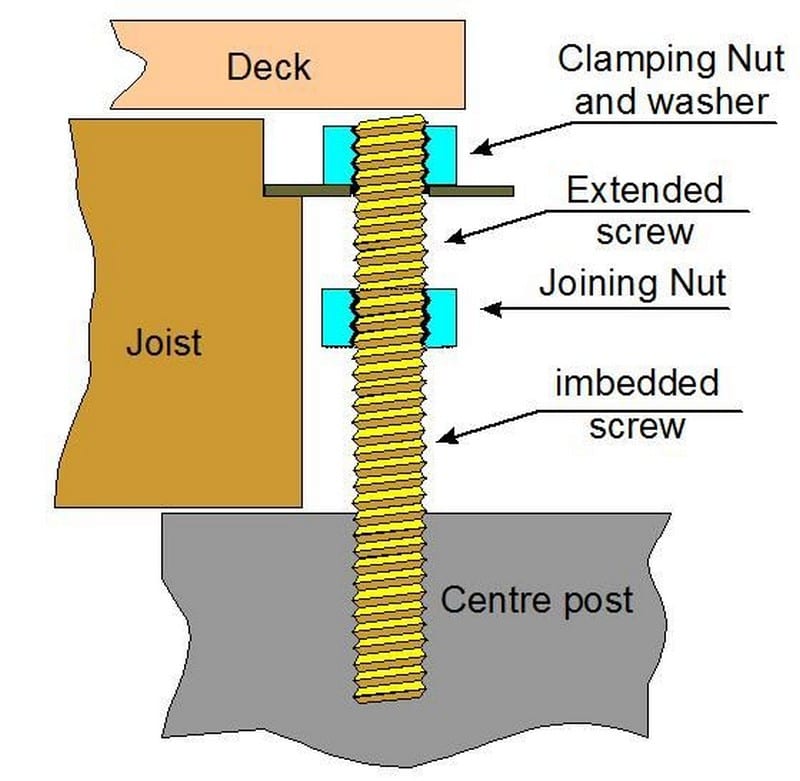
The connection of the octagonal deck to the house required a small alteration in the plan. Keep the octagon shape, but deck the space between the wall and the octagonal deck and make it obvious. Here is the framing between the deck and the house.
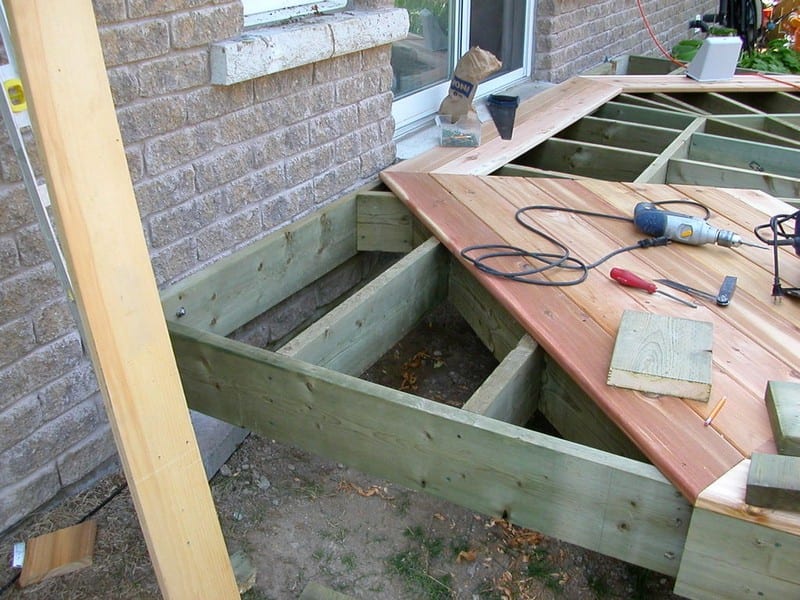
Here is the decking between the octagon and the house wall.
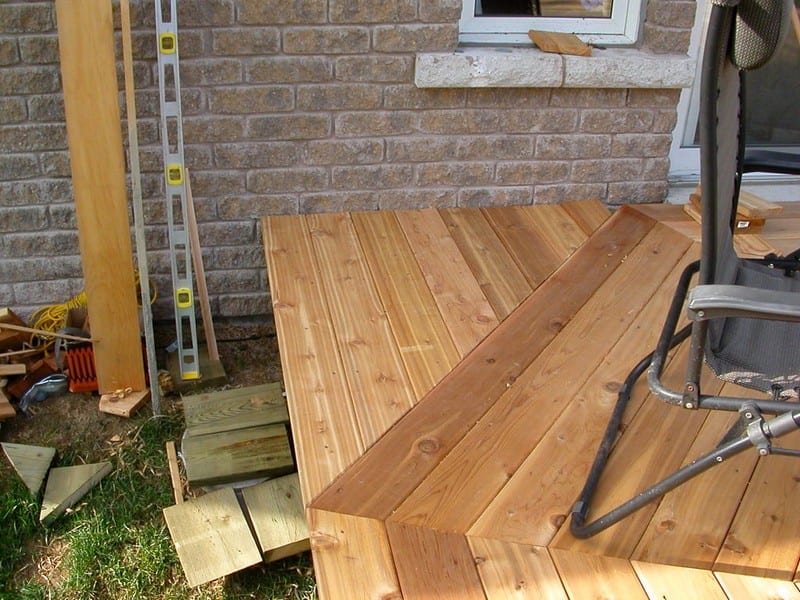
The octagonal deck looks great but my skills with the saw left rather wavy lines along the planking over the main joists. So my answer was to cover the joints with an inlay of cedar decking. Two reasons for this:
- Wavy lines
- Inlays clearly define the triangular segments of the octagon.

To do the inlay,
-Rip a 6-foot piece of cedar decking about 3/8 inches thick.
-Using the 7-1/4 inch saw to cut the channel straddling the saw joins along the main joists to about 1/4 inch depth.
-Fasten all joints in the channel with a deck screw and washer
-Use the contractor’s glue (waterproof) to glue the ripped strips into the channel.
-Use a hand plane to bring the level of the inlay to the octagonal deck surface. Sanding takes too much time.
(Sounds like “all ya gotta do is blah blah blah”)
Let’s start
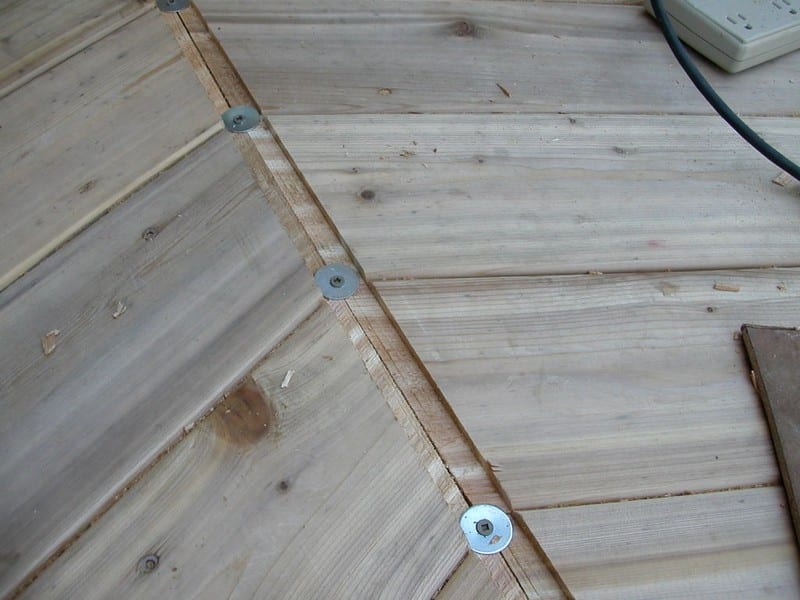
Using the ripped piece of decking mentioned above, straddle the saw join with the cedar strip so that it is centred above the join. Draw a line along the right edge of the strip. See the red dotted line in the diagram.
Measure your power saw edge guide. What is the measurement of the sawtooth closest to the edge guide? It should typically be about 1-1/4 inches. See the yellow rectangle in the diagram.
Use a piece of scrap wood no thicker than 1/4 inch and tack the scrap wood onto the octagonal deck to the right of the drawn line at a distance equal to the measurement of the guide to a saw blade, and parallel to that line. See the brown rectangle in the diagram.
Cut the vertice of the join to the centre of the deck. That’s 1/8″. put the cedar strip between the scrap wood guide and the saw. Make another cut. That’s a total of 1/2″ channel. You got it! proceed until you get close to the line on the left of the saw join.
Insert the strip, or make another cut. BE CAREFUL. MEASURE TWICE, AND CUT ONCE. PLEASE TRY ON A SCRAP OF WOOD BEFORE DOING THIS! When finished, clean out the uncut pieces with a wood chisel.
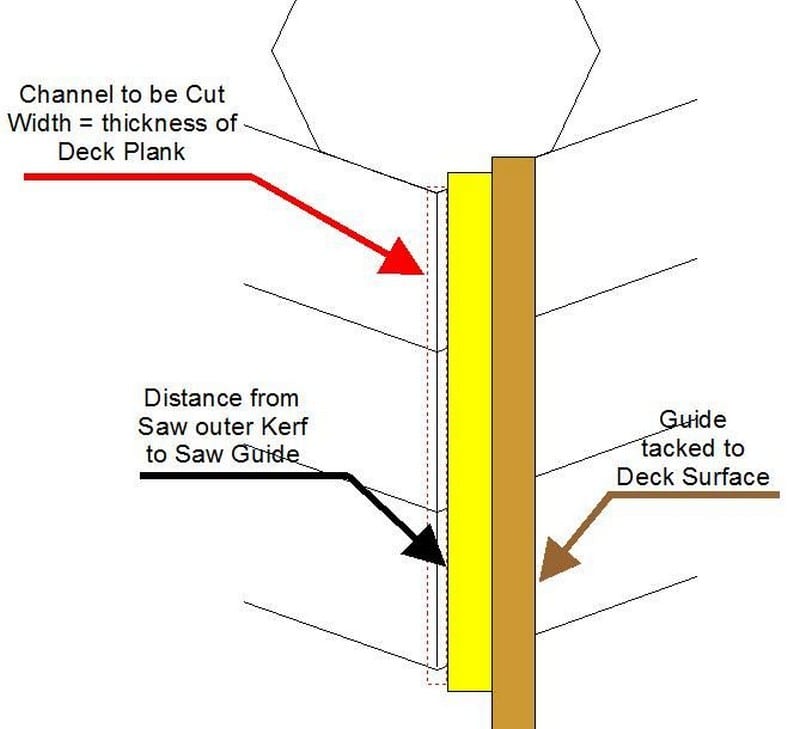
This shows four inlays in place.
It doesn’t require a genius to see the improvement of the design with the inlays. The lines at the main joists are dead straight, and the triangular features of the octagon pop right out.
Be sure to review this whole procedure. You don’t want to glue a strip down before screwing the joints down. In this picture (aside from my wife’s geraniums) notice that I had not decided how to finish the centre. I eventually decided on a one-piece cedar octagon.
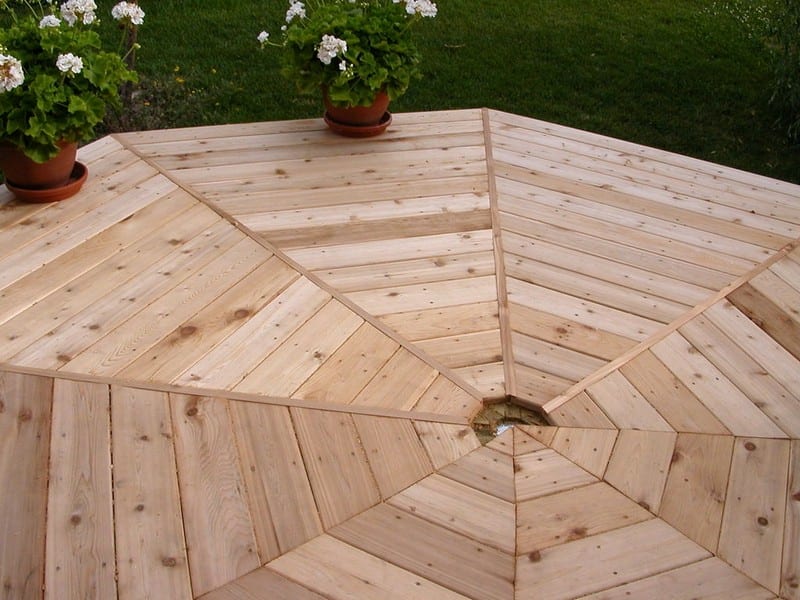
In our county, a hard roof on a gazebo or any deck changes all the rules. The setbacks for a deck move from 4 feet to 23 feet the minute your designs include a hard roof. The result is that I had to design a tent roof. This design started with the intention of cedar rails and a semi-permanent roof. Aside from the cost, the local engineering department said NO!
As it happens, my wife found a great buy on an octagonal garden tent (about $575 Cdn.) The problem was that the outfit selling the tent had little or no documentation and was not sure of the size. They guessed 14 feet. Does that mean a 7-foot edge-to-edge or 7-foot radius?
We bought it and found that the radius is about 13 feet 6 inches. They must include the diameter of the support poles in the 14 feet. Regardless here is where the last design mod is described. I couldn’t increase the current radius, but I could put in extensions to the vertices to support the tent poles. Each post support is constructed of 4 pieces of wood. T
Two sides at 8 inches, cutting both ends at 22.5 degrees, and two centrepieces at 4″, again with 22.5 degrees cut both ends. Assemble as shown here, glue and screw, and mount at each vertice below deck level. Fasten deck planks following the pattern of the deck with a 1-1/2 inch overhang.

That’s it, guys. I am not going to talk about the stairs, we all have been there.
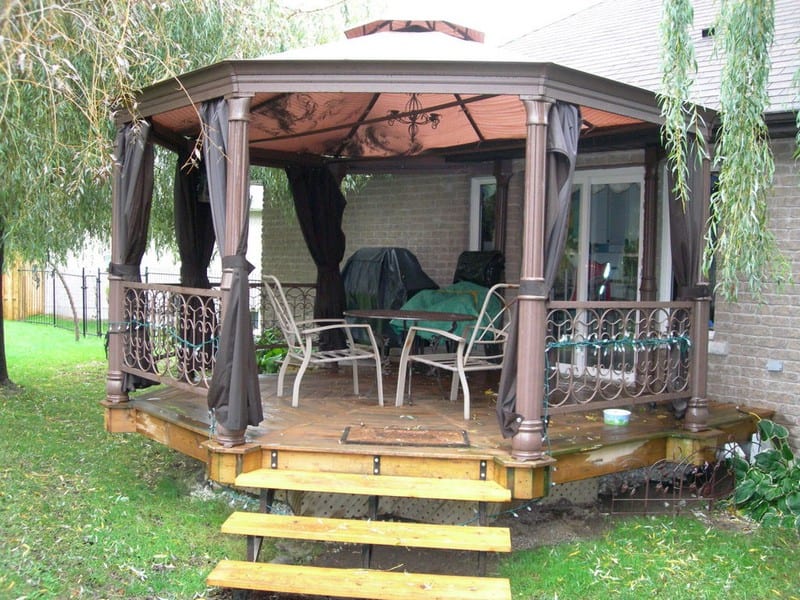
A couple of things:
- I sanded and refinished the deck in 2009. I probably will do it again in 2012.
- The reason for pushing the deck planks tight together came from my local lumber yard person who noted that shrinkage will occur regardless, but less with cedar than PT. His opinion has been vindicated since very little shrinkage has occurred. My fence pressure-treated fence planks have shrunk about 1/2 inch in width in the last 6 years.
- The deck has been very sturdy, even when a full band with instruments has been playing on it, no shaking or bouncing. (good lattice.)
Thanks to cobourgdave for this great tutorial!
Conclusion
Building an octagonal deck can transform your backyard into a stunning outdoor oasis, perfect for relaxation, entertainment, and enjoying nature. With the right materials, design considerations, and maintenance, your octagonal deck will not only enhance the beauty of your home but also provide a durable and versatile space for years to come
For more ways to improve your outdoor area, check out our kitchen expansion guide!


